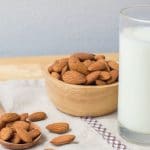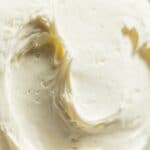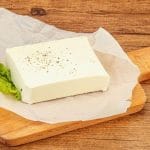In a nutshell: Yes, you can freeze cucumbers, but their texture will change due to their high water content. Freezing in a brine solution for pickles or using them in smoothies, soups, and dips are great options for enjoying frozen cucumbers.
Cucumbers bring a deliciously crunchy and juicy texture to salads, sandwiches, and snack platters. Although they have a neutral taste, they are often incorporated into savory dishes, juiced, or used in cold soups.
With a water content of almost 90 percent, it is no surprise that the notion of freezing cucumbers is generally frowned upon. However, you can freeze cucumbers successfully and use frozen cucumbers in many ways. So, don’t let your extra cucumbers go to waste!
From the ice cube method to the brine method, here is your full guide to successfully freeze cukes.
Can Cucumbers Be Frozen?
Yes, there are several ways to freeze cucumbers depending on what you wish to use it for. Due to the high water content, cucumbers won’t retain their texture after freezing. However, there are ways to preserve the crunch and even intensify the flavor when freezing cucumbers.
Simply placing a whole cucumber into the freezer will result in a pile of mush, so be sure to follow the below steps to ensure you get the best out of your frozen produce.
Frozen cucumbers can be used in smoothies, soups, juices and dips. Freezing it in a brine solution yields a fantastic cucumber pickle that can be added to salads, sandwiches, and as a relish with any meal.
How To Freeze Cucumbers
Step 1: Clean
Regardless of the method you choose for freezing cucumbers, you need to rinse the cucumbers in cold water first and remove any damaged or spoiled parts. Store-bought cucumbers have a wax coating. Lightly scrub the cucumbers to remove this layer.
Peeling is optional and a good choice if you are planning to use the cucumber in a soup or juice for a smoother end result. Once you have washed, scrubbed, and peeled the cucumbers, choose the most appropriate method for freezing below.
Method 1: Freezer Pickles in Brine
Although it takes a little extra prep time, pickling is the best way to preserve cucumbers for flavor and texture.
Step 2: Slice
Cut the cucumbers into thin slices using a sharp knife or mandolin.
Step 3: Season
Add sliced onions to the cucumber slices. One onion per 2 quarts of cucumber is ideal. In a large bowl, layer the onion and cucumber and sprinkle salt over each layer. Cover the mixture with cling film and let it sit for two hours.
Step 4: Rinse
Rinse the salt-soaked cucumber and onion mixture well in water.
Step 5: Brine
Prepare the brine mixture by mixing a half-cup white vinegar with 1.5 cups of sugar in a clean bowl. Stir the mixture to dissolve the sugar. Add the cucumber-onion mixture to the brine and optionally add celery seeds for additional flavor.
Step 6: Pack
The cucumber-brine mixture can be frozen in resealable freezer bags or freezer-friendly containers. Ladle the cucumber and brine mixture into the chosen containers and make sure to leave a half-inch of headspace as the liquid will expand on freezing.
If using resealable freezer bags, press out any excess air before sealing the packet.
Step 7: Label and Freeze
Label the container with the contents and date and place it upright in the freezer. Wait at least a week before eating to allow the pickling flavor time to infuse.
Method 2: Freeze Cucumber Slices or Cubes
Step 2: Cut
Cut the cleaned cucumber into slices, cubes, or spears.
Step 3: Flash Freeze
Spread the sliced cucumbers or cucumber spears in a single layer on a parchment-lined baking sheet. The parchment paper will prevent the pieces from sticking to the baking sheet as they freeze.
Place the tray in the freezer for a few hours until fully frozen. This quick-freeze process prevents the cucumber pieces from sticking together in a big clump, allowing you to remove just as much as you need from the freezer at a time.
Step 4: Pack
Remove the baking sheet from the freezer and pack the frozen cucumber slices into resealable freezer bags. Press out any remaining air before closing the bag.
Step 5: Label and Freeze
Label the bag with the date and place it in the freezer.
Method 3: Cucumber Ice Cubes
Step 2: Juice or Blend
Juice or puree the cucumbers in a blender.
Step 3: Freeze
Pour the cucumber water or puree into an ice cube tray and place it in the freezer until completely frozen.
Step 4: Bag It
Remove the frozen cubes from the ice cube trays and pack them into a resealable freezer bag or airtight container. This protects them from contact with air which will reduce the quality quickly. Press all the air out of the bag and seal.
Step 5: Label and Freeze
Label the zip top bag or freezer safe containers with the date and place it in the freezer.
Tip: If you are using these for drinks you can also add lemon juice, mint, or other herbs when making your ice cubes.
How To Thaw Frozen Cucumbers
Although cucumbers freeze well, they don’t defrost well, unless they’ve been pickled or if you are using them for a cold soup. The great things is you can use them frozen too. For the best results, add the frozen cucumbers or ice cubes to smoothies and juices. This means you can remove them straight from the freezer into the food processor or blender.
To defrost cucumber pickles, remove the bag or jar from the freezer and place it in the refrigerator to thaw overnight.
Types of Cucumbers
Although found in stores year-round, fresh cucumbers are actually warm-weather plants harvested in the summertime.
There are many types of cucumbers grown world-wide, however, the fruit can be categorized into three main groups namely slicing cucumbers, pickling cucumbers, and specialty cucumbers.
English cucumbers are the most common among the slicing category with their long and slender shape. The thin dark green skin surrounds a pale green juicy and crisp interior. Both the skin and flesh are eaten.
This type of cucumber is mostly used in green salad, cucumber salad, on sandwiches, or in drinks. They can be enjoyed with olive oil, lemon juice, salt, and seasonings as a simple side salad with with cream cheese on a sandwich. They can even be used for sorbets and granita. There are so many ways to use cucumbers and many cucumber recipes to discover.
Pickling cucumbers are smaller than slicing cucumbers, reaching a length of 4 inches when fully mature. They make great snacks and can be enjoyed raw or pickled. Alibi cucumbers are a typical and popular type of pickling cucumber.
Specialty cucumbers don’t have the same appearance as their slender green counterparts and are rarely found in general supermarkets. They are grown as a novelty and can be round or long in shape.
Lemon cucumbers are a prime example of the novelty type with a round shape, citrus flavor, and yellow color, but similar texture to regular cucumbers.
FAQs
Conclusion
Cucumber may seem like a boring salad ingredient at first, but it really is an incredibly versatile fruit that can be used in many ways after freezing. They’re ideal for adding a refreshing flavor to blended recipes.
Take care to clean them properly and protect the cucumbers from contact with air on freezing for the best results.
Whether used as a savory relish, spicy pickle, sweet smoothie, or incorporated into a creamy dip, there are loads of reasons to freeze cucumbers instead of letting them go to waste.
Up next: Can You Freeze Celery?
*Image by depositphotos.com/indrepau









